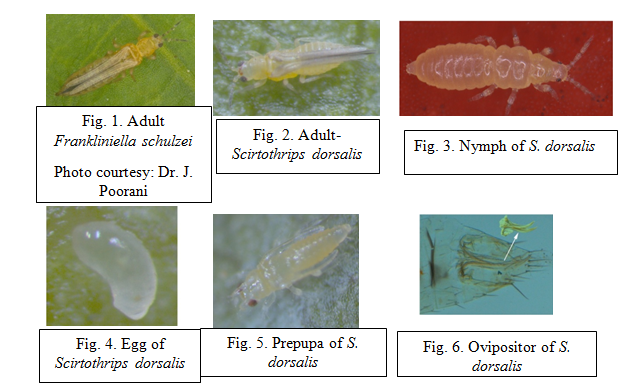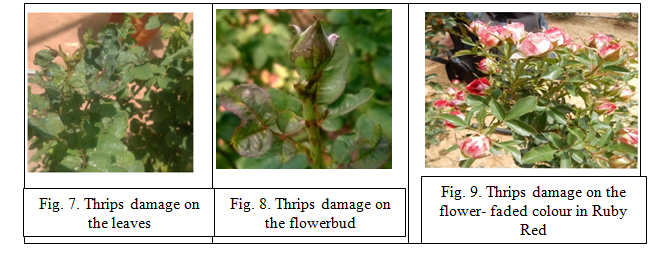Authors: Rachana, R. R, Salini, S, David, K.. J., Shivaprakash, T. H. M., Richa Varshney
National Bureau of Agricultural Insect Resources, Bangalore
Rose is a very important crop in floriculture industry with economic value both in the domestic as well as international markets. Rose cultivation in Karnataka state contributes a major share in floriculture industry of India. Meanwhile, the crop is very much vulnerable to several pests and diseases also. Among the various pests affecting rose, thrips are the most important ones, which causes damage to the crop both in terms of quantity as well as quality. Thrips pose an increasing threat to rose cultivation both in open field condition as well as in controlled conditions such as polyhouse cultivation. They are sucking pests and cause serious damage to flushes, flower buds, tender stem etc. by sucking plant sap.This results in serious damage to economic parts of the plant and in turn heavy loss to growers.
Rose thrips
There are several species of thrips affecting rose, of which the three major species namely Frankliniella schulzei (Trybom) , Thrips hawaiiensis (Morgan) and Scirtothrips dorsalis Hood are found to be the predominant ones. Majority of these species are polyphagous feeding on a wide variety of economically important crop plants like grapes, vegetables, ornamental crops etc. A few feed on leaves whereas the others feed on both leaves and flowers.

The adults are very small, 1–3.5 mm size, elongate and very fragile (Figs 1–3). They are fast moving with four narrow fringed wings. The female thrips lays about 50–100 eggs. Eggs (Fig. 4) are very small, more or less oval to bean shaped and inserted in the tender tissue on the underside of the leaves using a serrated sword-like ovipositor (Fig. 6). Hatching takes place in 2–7 days. Life cycle of thrips comprises of four immature stages namely first instar and second instar larvae (nymphs), pre-pupa (Fig. 5) and pupa. A few species pupate in soil whereas the others pupate on leaves itself. Nymphal duration is of 8–10 days and pupal period lasts for 2–4 days. The life cycle is completed in about 12–20 days. Nymphs (Fig. 3) are similar to adults but are without wings. Adult longevity is 13–15 days.

NATURE OF DAMAGE
Both nymphs and adults are damaging stages. They damage the tender plant surface by rasping and sucking the oozing sap. Initial symptoms of damage appear on young flushes as scarring or brown streaks and later on results in stunting and malformation. Affected tender leaves curve upwards and finally become malformed as they grow old. Feeding on flower bud initiation stage causes scarring of young flower buds (Fig. 8), especially the outer sepals leading to distorted buds that open only partially or abort prematurely. Thrips feeding on flower petals cause silvery-white or brown streaks on flower petals and ultimately loose the flower colour (Fig. 9) and also browning of their edges. Different stages of thrips can be seen in numerous numbers on affected flower buds once the petals are peeled off. The stunted and malformed young flushes are the initial symptoms (Fig. 7) whereas drying up of flower buds and flower shedding are the later stage symptoms.
CROP SCOUTING AND TRAPPING
Regular scouting is necessary to detect early infestations and also for the effective management of the pests. A crop scouting program includes both sticky trap cards and visual inspection. Scouting should be done once a week. A gentle tapping of the blossoms and growing points on a clean white paper aids in visual inspection. Install 4-5 blue/yellow sticky coloured traps per acre.
MANAGEMENT OF THRIPS
Field sanitation is to be maintained for eliminating the sources of thrips infestation. Cleaning of the field or polyhouse has to be undertaken at regular intervals by removing weeds, pruned plant parts or shed leaves as they may act as a source of infestation. It is better to burn the infested plant debris in order to destroy the various stages of the pest.Deep ploughing in summer/raking of soil in fields help to destroy pupal stages and thereby minimizes the incidence. Biological control using predatory mites will be useful if the infestation levels are low especially in the initial stages of the crop under green house conditions. Release of 1-5 predatory phytoseid mites, Amblyseius cucumeris and A. swirskii, per plant can effectively manage early instar thrips. Spraying of fungal pathogens namely Lecanicillium lecanii or Beauveria bassiana @ 5 ml or 5 g/l helps in reducing thrips population in cold and humid climate especially at 20-25°C temperature and more than 80% relative humidity. Botanicals such as various neem formulations (EC based) depending upon the strength of botanical viz., 1% @ 2.5 ml and 5% @ 0.5 ml/l can be sprayed like insecticide @ 400 litre spray solution per acre in order to reduce the pest load on the crop. Chemical control using insecticides play an important role in the effective management of thrips. Spraying of any one of the following insecticides on a rotation basis can manage the thrips. List of insecticides recommended to manage thrips are detailed in Table 1.
Table 1: List of insecticides recommended for thrips management
| Sl. No. | Insecticides | Dose |
| 1. | Dimethoate 30 EC | 1320 ml/ha |
| 2. | Chloropyriphos 50% + Cypermethrin 5% EC | 1000 ml/ha |
| 3. | Chlorfenpyr 10% SC | 750–1000 ml/ha |
| 4. | Fipronil 5% SC | 800–1000 ml/ha |
| 5. | Fipronil 80% w/w | 50–62.5 g/ha |
| 6. | Spinetoram 11.7% SC | 450 ml/ha |
| 7. | Spinosad 45% SC | 187 ml/ha |
About Author / Additional Info: